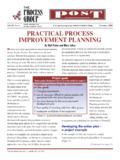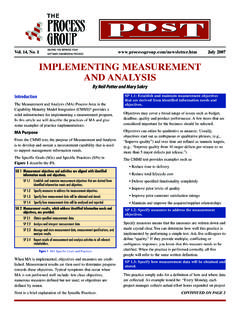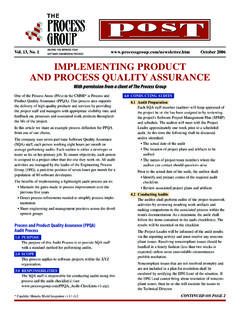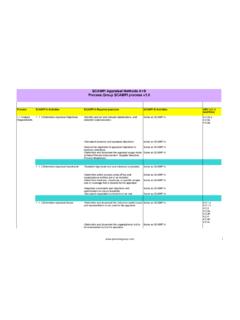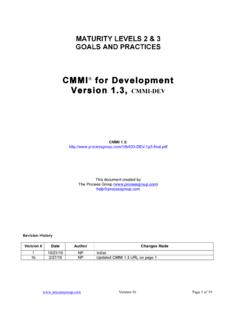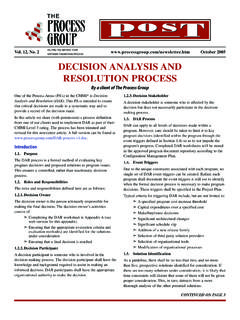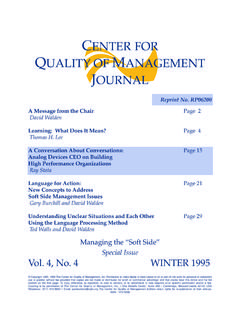Transcription of HELPING YOU IMPROVE VOL 18 NO 2 YOUR …
1 1 HELPING YOU IMPROVE your engineering process SCAMPI CHANGES By Neil Potter and Mary Sakry !"#$%&'(#)%"*In March 2011 the SEI released a new version of the SCAMPI1 appraisal method. In this article we discuss the major changes. The article covers: Terminology Changes Scoping and Sampling Data Coverage Rules Managed Discovery Appraisal Team Training Conflicts of Interest Appraisal Team Qualifications Appraisals including Multiple Models Dates to Watch Out For +,$-)"%.%/0*123"/,4*From the Method Definition Document (MDD), the following changes are described: Artifacts The distinction between direct and indirect artifacts has been removed.
2 This distinction was often confusing and could unnecessarily drive data collection costs higher. The more general term artifact is used now. Artifacts - a tangible form of objective evidence indicative of work being performed that represents either the primary output of a model practice or a consequence of implementing a model practice. These artifacts may include organizational policies, meeting minutes, review results, or other implementation-level work products. Affirmations - an oral or written statement confirming or supporting implementation (or lack of implementation) of a model practice provided by the implementers of the practice, provided via an interactive forum in which the appraisal team has control over the interaction.
3 These statements are typically collected using interviews, demonstrations, questionnaires, or other means. Focus and non-focus projects: The terms focus project and non-focus project were removed in to better reflect the new sampling approach and to avoid confusion that has occasionally occurred with these terms in prior method versions. The same concept is reflected in data sampling and coverage rules (see later). Appraisal input: The Appraisal Input document has been removed. Content previously required by the appraisal input is reflected in the initial appraisal plan.
4 Determine Data Collection Strategy (activity ) This is a new activity added to the method. The data collection strategy outlines the overall high-level scheme for data collection making it more explicit than before. This includes: The choice of data collection approach (discovery, managed discovery, and/or verification). When the data will be collected ( , preparation VOL. 18 NO. 2 1 Full text: Standard CMMI Appraisal Method for process Improvement (SCAMPI) A, Version : Method Definition Document (MDD) June 2011 2 phase or conduct phase).
5 What data collection techniques ( , demonstrations, presentations, interviews and questionnaires) will be employed for both objective evidence types (artifacts and affirmations). How and when all evidence types will be collected (artifacts and affirmations). The organization responsible for collecting the data. !"#$%&'()&*(!)+$,%&'(This is the biggest change in the SCAMPI method and will probably cause the most problems. The intent is to IMPROVE the previous sampling algorithm, which referred to Focus and Non-focus projects. Organizations sometimes abused this by selecting the best three projects from an organization (regardless of its size) and stating that these were a representative sample.)
6 The new sampling rules define a specific set of criteria that must be considered to define the sample. The result is intended to be a better sample, more consistent among appraisals and transparent (or auditable). Only time will tell if this is indeed the case. The MDD states: An organization is made up of basic units. These identify blocks of work, or people, who form the elements of the organizational unit to be sampled. Examples of basic units include projects, work groups, and teams. The concept of a support function has also been introduced to explicitly account for other structures within the organizational unit that do not tend to do customer-facing work.
7 Examples of support functions include Quality Assurance or process engineering groups. Sampling factors serve to identify meaningful differences in the conditions under which work is performed in the organizational unit. The following candidate sampling factors must be evaluated to determine the organizational scope of the appraisal: Location: if work is performed differently in different locations ( , countries, cities, sites or installations). Customer: if work is performed differently depending on the customer served by that work.
8 Size: if work is performed differently based on the size of the basic unit or support function. Organizational Structure: if work is performed differently in different parts of the organizational structure ( , different divisions as depicted on an organization chart). Type of Work: if work is performed differently based on the type of work ( , system integration, software development, IT-support services, or help-desk). Other example sampling factors considered could include funding source, duration and complexity. Subgroups, derived from the sampling factors, are a collection of basic units that perform work in a similar way.
9 A representative sample for the organizational unit (the name of the group that can claim the appraisal result) is established by selecting basic units from each of the subgroups according to the formula at the top of page 3. To explain the new selection calculation, we describe an example below. Example Company X has 6 projects in total, split between 2 sites (Dallas and Austin). The projects are either software development or system integration. The relevant sampling factors are determined to be location and type of work. The total number of possible subgroups (see Table 1) is therefore 4 ( , System Integration Austin, System Integration Dallas, Software Development Austin and Software Development Dallas).
10 Note that the actual number of subgroups is 3 since there is no Software Development work in Dallas. The number of basic units ( , projects) in the organization is 6. The number of basic units that must be sampled is proportional to how many basic units there are in a subgroup. More than the minimum can be sampled, 3 System Integration Software Development Austin 1 basic unit 2 basic units Dallas 3 basic units 0 basic units Basic Units at Each Location Basic Units Sampled Austin System Integration 1 1 ( , 3 subgroups x 1 basic unit / 6 total basic units = ) Austin Software Development 2 1 ( , 3 x 2 / 6 = ) Dallas System Integration 3 2 ( , 3 x 3 / 6 = ) but the equation defines the minimum.
